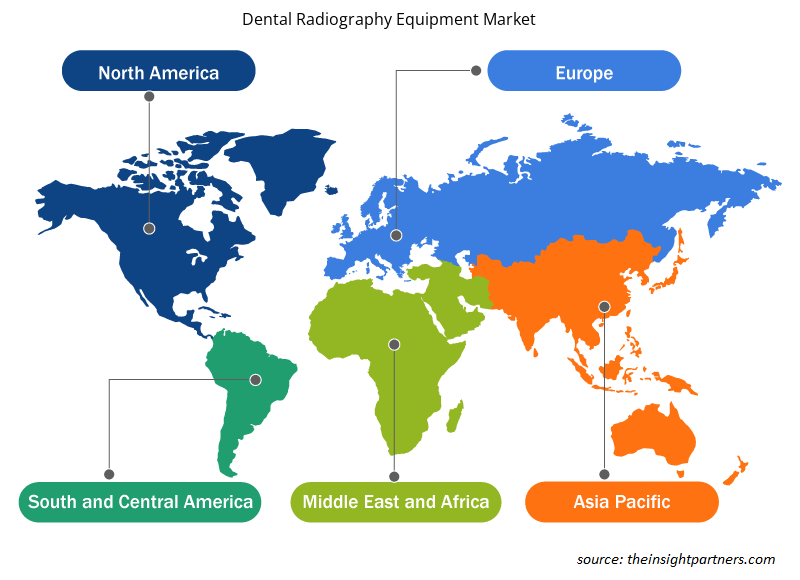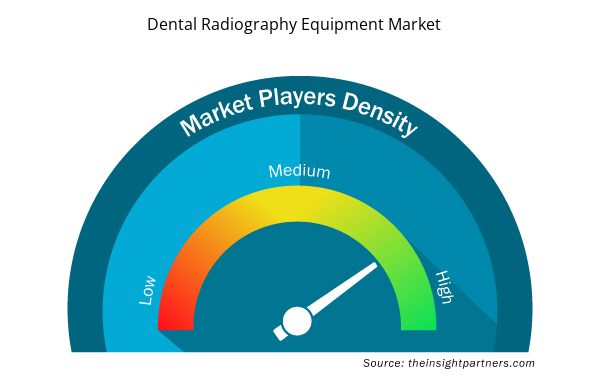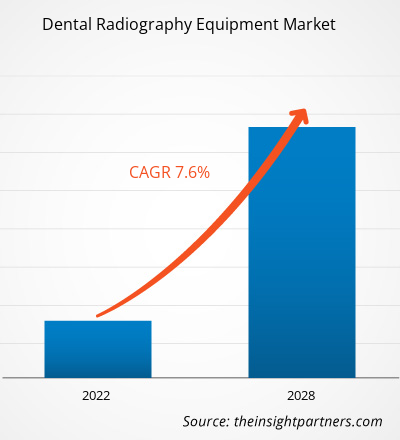Der Markt für zahnärztliche Röntgengeräte wurde im Jahr 2021 auf 2.559,09 Millionen US-Dollar geschätzt; von 2022 bis 2028 wird eine durchschnittliche jährliche Wachstumsrate (CAGR) von 7,6 % erwartet.
Dentalradiologiegeräte werden in Krankenhäusern, Zahnkliniken und Diagnosezentren häufig zur zahnmedizinischen Bildgebung verwendet, um Zahnerkrankungen, Karies und Erkrankungen wie Zahnfäule, Zahnfleischentzündungen und Zahnkaries zu diagnostizieren. Diese Instrumente werden mit niedriger Strahlung zur Bildaufnahme verwendet.
Der Markt für zahnärztliche Röntgengeräte ist nach Produkt, Endverbraucher und Geografie segmentiert. Geografisch ist der Markt grob in Nordamerika, Europa, Asien-Pazifik, den Nahen Osten und Afrika sowie Süd- und Mittelamerika unterteilt. Der Marktbericht für zahnärztliche Röntgengeräte bietet Einblicke und eine eingehende Analyse des Marktes, wobei Markttrends, technologische Fortschritte, Marktdynamik und die Wettbewerbsanalyse des weltweit führenden Marktteilnehmers im Vordergrund stehen.
Passen Sie diesen Bericht Ihren Anforderungen an
Sie erhalten kostenlos individuelle Anpassungen an jedem Bericht, einschließlich Teilen dieses Berichts oder einer Analyse auf Länderebene, eines Excel-Datenpakets sowie tolle Angebote und Rabatte für Start-ups und Universitäten.
- Holen Sie sich die wichtigsten Markttrends aus diesem Bericht.Dieses KOSTENLOSE Beispiel umfasst eine Datenanalyse von Markttrends bis hin zu Schätzungen und Prognosen.
Markteinblicke
Steigendes Bewusstsein für orale Erkrankungen wird den Markt für zahnärztliche Röntgengeräte in den kommenden Jahren ankurbeln
Der Welttag der Mundgesundheit wurde von der Fédération Dentaire Internationale (FDI) ins Leben gerufen. Es handelt sich um die größte globale Aufklärungskampagne zum Thema Mundgesundheit. Die jährliche Kampagne sensibilisiert Erwachsene und Kinder für Mundhygienepraktiken und verdeutlicht die Bedeutung der Mundgesundheit für die allgemeine Gesundheit und das Wohlbefinden. Jedes Jahr sensibilisiert der Community Dental Services (CDS) in London für Mundgesundheit. Der Mouth Cancer Action Month dauert den gesamten November. Die Kampagne von The Mouth Cancer Action sensibilisiert für Zahnerkrankungen, ihre Verbreitung und die Bedeutung einer regelmäßigen Überprüfung der Zahngesundheit. Das Oral Health Promotion-Team von The Mouth Cancer Action verbreitet diese Botschaften und verteilt die Kampagnenmaterialien im Laufe des Monats weiträumig.
Darüber hinaus werden in Großbritannien verschiedene Kampagnen durchgeführt, um das Bewusstsein für Mundkrankheiten zu stärken. Der National Smile Month beispielsweise ist die größte und am längsten laufende Kampagne Großbritanniens zur Förderung einer guten Mundgesundheit. Die Kampagne wird hauptsächlich von der Oral Health Foundation organisiert und hat das Ziel, die Mundgesundheit der Menschen im ganzen Land zu verbessern. Im September 2017 startete die British Society of Pediatric Dentistry (BSPD) „Dental Check by One“ (DCby1), um frühzeitige Zahnarztbesuche zu fördern. DCby1 ist eine öffentliche Gesundheitskampagne, die darauf abzielt, die Zahnarztbesuche von Kindern im Alter von 0–2 Jahren zu erhöhen. In Irland begeht die Mouth Head and Neck Cancer Awareness Ireland Group jeden September den Mouth Cancer Awareness Day (MCAD). Mundkrankheiten haben daher in den letzten Jahren beträchtliche Aufmerksamkeit erhalten. Es wird erwartet, dass öffentliche Aufklärungskampagnen in den kommenden Jahren reichlich Möglichkeiten für das Wachstum des Marktes für zahnärztliche Röntgengeräte schaffen werden.
Produktinformationen
Basierend auf dem Produkt ist der Markt für zahnärztliche Röntgengeräte in intraorale Röntgensysteme, extraorale Röntgensysteme, intraorale Plattenscanner und Cone-Beam-Computertomographie-Bildgebungssysteme (CBCT) unterteilt. Das Segment der intraoralen Röntgensysteme wird voraussichtlich im Jahr 2022 den größten Marktanteil haben. Es wird jedoch erwartet, dass das Segment der Cone-Beam-Computertomographie im Prognosezeitraum die höchste durchschnittliche jährliche Wachstumsrate von 8,7 % auf dem Markt verzeichnet. Dentale CBCT-Röntgenbilder liefern dreidimensionale (3D) Informationen, im Gegensatz zu den zweidimensionalen (2D) Informationen, die ein herkömmliches Röntgenbildgebungssystem liefert. Dies kann Zahnärzten bei der Diagnose, Planung und Bewertung bestimmter Zahnerkrankungen helfen.
Erkenntnisse für Endbenutzer
Basierend auf dem Endverbraucher ist der Markt für zahnärztliche Röntgengeräte in Zahnkliniken, Krankenhäuser, ambulante chirurgische Zentren und andere unterteilt. Das Krankenhaussegment wird im Jahr 2022 wahrscheinlich den größten Marktanteil haben. Es wird jedoch erwartet, dass das Segment Zahnkliniken im Prognosezeitraum die höchste durchschnittliche jährliche Wachstumsrate (CAGR) von 8,0 % auf dem Markt verzeichnet. Zahnkliniken sind kleinere Einrichtungen als Krankenhäuser, bieten jedoch auch spezielle Dienstleistungen für Besucher an. Viele Zahnkliniken sind auch mit Universitäten verbunden und bieten kostengünstige Dienstleistungen an.
Regionale Einblicke in den Markt für zahnärztliche Röntgengeräte
Die regionalen Trends und Faktoren, die den Markt für zahnärztliche Röntgengeräte im Prognosezeitraum beeinflussen, wurden von den Analysten von Insight Partners ausführlich erläutert. In diesem Abschnitt werden auch die Marktsegmente und die Geografie für zahnärztliche Röntgengeräte in Nordamerika, Europa, im asiatisch-pazifischen Raum, im Nahen Osten und Afrika sowie in Süd- und Mittelamerika erörtert.

- Erhalten Sie regionale Daten zum Markt für zahnärztliche Röntgengeräte
Umfang des Marktberichts zu zahnärztlichen Röntgengeräten
| Berichtsattribut | Details |
|---|---|
| Marktgröße im Jahr 2021 | 2,56 Milliarden US-Dollar |
| Marktgröße bis 2028 | 4,24 Milliarden US-Dollar |
| Globale CAGR (2021 - 2028) | 7,6 % |
| Historische Daten | 2019-2020 |
| Prognosezeitraum | 2022–2028 |
| Abgedeckte Segmente | Nach Produkt
|
| Abgedeckte Regionen und Länder | Nordamerika
|
| Marktführer und wichtige Unternehmensprofile |
|
Marktteilnehmerdichte für zahnärztliche Röntgengeräte: Auswirkungen auf die Geschäftsdynamik verstehen
Der Markt für Dentalradiographiegeräte wächst rasant, angetrieben durch die steigende Nachfrage der Endnutzer aufgrund von Faktoren wie sich entwickelnden Verbraucherpräferenzen, technologischen Fortschritten und einem größeren Bewusstsein für die Vorteile des Produkts. Mit steigender Nachfrage erweitern Unternehmen ihr Angebot, entwickeln Innovationen, um die Bedürfnisse der Verbraucher zu erfüllen, und nutzen neue Trends, was das Marktwachstum weiter ankurbelt.
Die Marktteilnehmerdichte bezieht sich auf die Verteilung der Firmen oder Unternehmen, die in einem bestimmten Markt oder einer bestimmten Branche tätig sind. Sie gibt an, wie viele Wettbewerber (Marktteilnehmer) in einem bestimmten Marktraum im Verhältnis zu seiner Größe oder seinem gesamten Marktwert präsent sind.
Die wichtigsten auf dem Markt für zahnärztliche Röntgengeräte tätigen Unternehmen sind:
- Zimed Healthcare GmbH
- Envista Holdings Corporation
- General Electric Co
- Dentallabor.
- Dentsply Sirona Inc.
Haftungsausschluss : Die oben aufgeführten Unternehmen sind nicht in einer bestimmten Reihenfolge aufgeführt.

- Überblick über die wichtigsten Akteure auf dem Markt für zahnärztliche Röntgengeräte
Firmenprofile
Der Markt für zahnärztliche Röntgengeräte wird hauptsächlich von Zimed Healthcare Ltd, Envista Holdings Corporation, General Electric Co, Carestream Dental LLC, Dentsply Sirona Inc., Planmeca, Koninklijke Philips NV, Acteon Group, Siemens Healthcare GmbH und Vatech Co., Ltd. dominiert.
Nachfolgend sind Beispiele für Entwicklungen aufgeführt, die diese Akteure unternommen haben, um das Wachstum des Marktes für zahnärztliche Röntgengeräte zu fördern:
- Im September 2020 brachte Carestream Dental das 3D-Bildgebungssystem CS 8200 auf den Markt. Es handelt sich um ein multimodales System, das Funktionen für CBCT-Bildgebung, 2D-Panoramabildgebung, optionale kephalometrische Bildgebung und 3D-Objektscans mit größerem Sichtfeld (FOVs) sowie fortschrittliche Algorithmen bietet, die Ärzten eine bessere Sicht ermöglichen.
- Im März 2022 übernahm die Envista Holdings Corporation das Intraoralscanner-Geschäft von Carestream Dental. Das übernommene Unternehmen wurde in DEXIS umbenannt und ist nun Teil des Segments Envista Equipment and Consumables.
- Im September 2020 brachte Carestream Dental sein 3D-Bildgebungssystem CS 8200 auf den Markt. Es handelt sich um ein multimodales System, das CBCT-Bildgebung, 2D-Panoramabildgebung, optionale kephalometrische Bildgebung und 3D-Objektscans mit den zusätzlichen Verbesserungen eines größeren Sichtfelds (FOVs) und fortschrittlicher Algorithmen bietet, die den Ärzten eine bessere Sicht ermöglichen.
- Im Oktober 2019 brachte Dentsply Sirona Orthophos-Systeme auf den Markt, die effiziente und zuverlässige Diagnosen, intuitive digitale Arbeitsabläufe und hohe Bildqualität bei niedriger Dosis ermöglichen und damit Premiumlösungen für zahlreiche Anwendungen bieten.
- Historische Analyse (2 Jahre), Basisjahr, Prognose (7 Jahre) mit CAGR
- PEST- und SWOT-Analyse
- Marktgröße Wert/Volumen – Global, Regional, Land
- Branche und Wettbewerbsumfeld
- Excel-Datensatz



Report Coverage
Revenue forecast, Company Analysis, Industry landscape, Growth factors, and Trends

Segment Covered
This text is related
to segments covered.

Regional Scope
North America, Europe, Asia Pacific, Middle East & Africa, South & Central America

Country Scope
This text is related
to country scope.
Häufig gestellte Fragen
The global dental radiography equipment market, by product is categorized into intraoral X-ray systems, extra oral X-ray systems, intraoral plate scanners, and Cone-Beam Computed Tomography (CBCT) imaging. The intraoral X-ray systems segment held the largest share of the market in 2021. However, the Cone-Beam Computed Tomography (CBCT) imaging segment is anticipated to register the highest CAGR in the market during the forecast period.
The dental radiography equipment market majorly consists of the players such as Zimed Healthcare Ltd; Envista Holdings Corporation; General Electric Co; Carestream Dental LLC.; Dentsply Sirona Inc.; Planmeca; Koninklijke Philips NV; Acteon Group; Siemens Healthcare GmbH; and Vatech Co., Ltd.
Dental radiology equipment refers to the equipment that is used for dental imaging to diagnose various dental disorders, dental cavities, and dental diseases such as tooth decay, gingivitis, dental caries and others. Dental X-rays (radiographs) are images of one's teeth that dentist use to evaluate oral health.
Factors such as the rising prevalence of cancer and increasing awareness regarding cancer are propelling the market growth. However, the elevated risk of adverse effects due to dental radiography equipment is hampering the market's growth.
Trends and growth analysis reports related to Life Sciences : READ MORE..
The List of Companies - Dental Radiography Equipment Market
- Zimed Healthcare Ltd
- Envista Holdings Corporation
- General Electric Co
- Carestream Dental LLC.
- Dentsply Sirona Inc.
- Planmeca
- Koninklijke Philips NV
- Acteon Group
- Siemens Healthcare GmbH
- Vatech Co., Ltd
The Insight Partners performs research in 4 major stages: Data Collection & Secondary Research, Primary Research, Data Analysis and Data Triangulation & Final Review.
- Data Collection and Secondary Research:
As a market research and consulting firm operating from a decade, we have published and advised several client across the globe. First step for any study will start with an assessment of currently available data and insights from existing reports. Further, historical and current market information is collected from Investor Presentations, Annual Reports, SEC Filings, etc., and other information related to company’s performance and market positioning are gathered from Paid Databases (Factiva, Hoovers, and Reuters) and various other publications available in public domain.
Several associations trade associates, technical forums, institutes, societies and organization are accessed to gain technical as well as market related insights through their publications such as research papers, blogs and press releases related to the studies are referred to get cues about the market. Further, white papers, journals, magazines, and other news articles published in last 3 years are scrutinized and analyzed to understand the current market trends.
- Primary Research:
The primarily interview analysis comprise of data obtained from industry participants interview and answers to survey questions gathered by in-house primary team.
For primary research, interviews are conducted with industry experts/CEOs/Marketing Managers/VPs/Subject Matter Experts from both demand and supply side to get a 360-degree view of the market. The primary team conducts several interviews based on the complexity of the markets to understand the various market trends and dynamics which makes research more credible and precise.
A typical research interview fulfils the following functions:
- Provides first-hand information on the market size, market trends, growth trends, competitive landscape, and outlook
- Validates and strengthens in-house secondary research findings
- Develops the analysis team’s expertise and market understanding
Primary research involves email interactions and telephone interviews for each market, category, segment, and sub-segment across geographies. The participants who typically take part in such a process include, but are not limited to:
- Industry participants: VPs, business development managers, market intelligence managers and national sales managers
- Outside experts: Valuation experts, research analysts and key opinion leaders specializing in the electronics and semiconductor industry.
Below is the breakup of our primary respondents by company, designation, and region:

Once we receive the confirmation from primary research sources or primary respondents, we finalize the base year market estimation and forecast the data as per the macroeconomic and microeconomic factors assessed during data collection.
- Data Analysis:
Once data is validated through both secondary as well as primary respondents, we finalize the market estimations by hypothesis formulation and factor analysis at regional and country level.
- Macro-Economic Factor Analysis:
We analyse macroeconomic indicators such the gross domestic product (GDP), increase in the demand for goods and services across industries, technological advancement, regional economic growth, governmental policies, the influence of COVID-19, PEST analysis, and other aspects. This analysis aids in setting benchmarks for various nations/regions and approximating market splits. Additionally, the general trend of the aforementioned components aid in determining the market's development possibilities.
- Country Level Data:
Various factors that are especially aligned to the country are taken into account to determine the market size for a certain area and country, including the presence of vendors, such as headquarters and offices, the country's GDP, demand patterns, and industry growth. To comprehend the market dynamics for the nation, a number of growth variables, inhibitors, application areas, and current market trends are researched. The aforementioned elements aid in determining the country's overall market's growth potential.
- Company Profile:
The “Table of Contents” is formulated by listing and analyzing more than 25 - 30 companies operating in the market ecosystem across geographies. However, we profile only 10 companies as a standard practice in our syndicate reports. These 10 companies comprise leading, emerging, and regional players. Nonetheless, our analysis is not restricted to the 10 listed companies, we also analyze other companies present in the market to develop a holistic view and understand the prevailing trends. The “Company Profiles” section in the report covers key facts, business description, products & services, financial information, SWOT analysis, and key developments. The financial information presented is extracted from the annual reports and official documents of the publicly listed companies. Upon collecting the information for the sections of respective companies, we verify them via various primary sources and then compile the data in respective company profiles. The company level information helps us in deriving the base number as well as in forecasting the market size.
- Developing Base Number:
Aggregation of sales statistics (2020-2022) and macro-economic factor, and other secondary and primary research insights are utilized to arrive at base number and related market shares for 2022. The data gaps are identified in this step and relevant market data is analyzed, collected from paid primary interviews or databases. On finalizing the base year market size, forecasts are developed on the basis of macro-economic, industry and market growth factors and company level analysis.
- Data Triangulation and Final Review:
The market findings and base year market size calculations are validated from supply as well as demand side. Demand side validations are based on macro-economic factor analysis and benchmarks for respective regions and countries. In case of supply side validations, revenues of major companies are estimated (in case not available) based on industry benchmark, approximate number of employees, product portfolio, and primary interviews revenues are gathered. Further revenue from target product/service segment is assessed to avoid overshooting of market statistics. In case of heavy deviations between supply and demand side values, all thes steps are repeated to achieve synchronization.
We follow an iterative model, wherein we share our research findings with Subject Matter Experts (SME’s) and Key Opinion Leaders (KOLs) until consensus view of the market is not formulated – this model negates any drastic deviation in the opinions of experts. Only validated and universally acceptable research findings are quoted in our reports.
We have important check points that we use to validate our research findings – which we call – data triangulation, where we validate the information, we generate from secondary sources with primary interviews and then we re-validate with our internal data bases and Subject matter experts. This comprehensive model enables us to deliver high quality, reliable data in shortest possible time.


 Holen Sie sich ein kostenloses Muster für diesen Bericht
Holen Sie sich ein kostenloses Muster für diesen Bericht